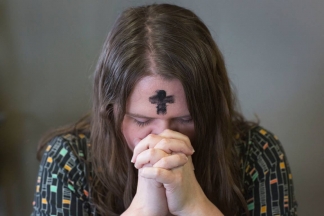news article
Practices to consider during Lent
February 3, 2021 / By UNY Communications
What is Lent?
Lent is a season of 40 days, not counting Sundays, which begins on Ash Wednesday and ends on Holy Saturday. Lent comes from the Anglo Saxon word lencten, meaning “lengthen” and refers to the lengthening days of spring. The 40 days represents the time Jesus spent in the wilderness, enduring the temptation of Satan,and preparing to begin his ministry.
Lent is a time of repentance, fasting and preparation for the coming of Easter. It is a time of self-examination and reflection. In the early church, Lent began as a period of fasting and preparation for baptism by new converts and then became a time of penance by all Christians. Today, Christians focus on relationship with God, growing as disciples and extending ourselves, often choosing to give up something or to volunteer and give of ourselves for others.
Sundays in Lent are not counted in the 40 days because each Sunday represents a "mini-Easter." This is why you will see the designation "Sunday in Lent" rather than "Sunday of Lent" in the naming of these Sundays. On each Lord's Day in Lent, while Lenten fasts continue, the reverent spirit of Lent is tempered with joyful anticipation of the Resurrection.
During Ash Wednesday services on the first day of Lent, many United Methodist pastors will invite their congregations "to observe a holy Lent: by self–examination and repentance; by prayer, fasting, and self–denial; and by reading and meditating on God's Holy Word" (from the United Methodist Book of Worship). While you may be aware of this season leading up to Easter, you may wonder how you might "observe a holy Lent.
This 40-day journey called Lent is a wonderful opportunity to grow in your faith. Find your path of self-reflection and spiritual discovery, and invite others to join you as you seek to observe a holy Lent.
There is no one prescribed way. Instead, we are each encouraged to find our own method of confronting our sinfulness, remembering our mortality, and giving thanks for the gift of salvation we receive through the life, death, and resurrection of Jesus Christ. Here are some practices:
Fasting
One of the more common practices is to give something up for Lent. Some abstain from chocolate, social media, shopping, or something else through the season. This is a religious practice known as fasting. We fast to reorient ourselves away from the distraction of those things, and back toward God.
Another way to reorient your life toward God, is to focus on devotional practices like Bible study and prayer during the season.
Bible reading
Many do not know where to begin when reading the Bible. You can visit The Upper Room for daily devotions at https://www.upperroom.org/devotionals to help guide you in this pursuit. It provides a scripture passage and wonderfully thought-provoking and spirit-enriching material to read and think about each day.
Prayer
In the busyness of our everyday lives, prayer can sometimes get squeezed out. Lent is a wonderful time to intentionally work toward finding more time in your life for prayer. You can experiment with different ways to pray during the season, or really delve into a new-to-you way of praying. Enriching your prayer life is a great way to spend Lent.
Service
Another way to observe a holy Lent is to take on a new way of serving. Throughout the 40 days of the season you can adopt a new habit of volunteering in the community, making special financial gifts to service organizations, or participating in a small group.
Rest
An important practice with which many of us struggle is the spiritual discipline of rest or Sabbath. We don't have to rest on Saturday, the traditional Sabbath day, or even Sunday. You can instead find moments during an ordinary day to be still in God's presence. You might choose to spend a few minutes during lunch with a desktop meditation or listen to sermons as you prepare meals. Each can be a great way of enriching your Lent.
Learning
Learning about rituals specific to the season can enhance your worship. You may want to know more about the ashes used on Ash Wednesday, a Maundy Thursday footwashing service you're considering attending, or the Tenebrae service your congregation is planning for Good Friday.
You may also choose to learn more about baptism and communion, the sacraments of the church. Each has a connection to Lent and Easter.
Worship
Many United Methodist churches offer services on Ash Wednesday to begin of Lent, and other special services during Holy Week, the final days leading up to Easter. There may also be special times of prayer, study, and other gatherings that will help you continue your journey throughout the season. If you are not connected to a United Methodist congregation, use Find-A-Church to locate one close to you.
Children’s Education
You can also educate your children about Lent. Visit https://www.upperroom.org/lent for a calendar that has several ways for children to celebrate Lent with unique ideas such as:
- Making colorful candleholders: Instructions are provided in this calendar and the children are asked to place some of the candles on their dinner table to remind them of Christ, the light of the world.
- Give up complaining for a day.
- Create a praise tree: Instructions are provided for this craft and the children are asked to place the tree in a place where everyone in their family will see it. The children are also asked to let this tree become a reminder to pause each Sunday (and any other time) during Lent to offer God thanks and praise for all their blessings.
What are some unique ways that your family or church celebrate Lent? Send your stories to news@unyumc.org.